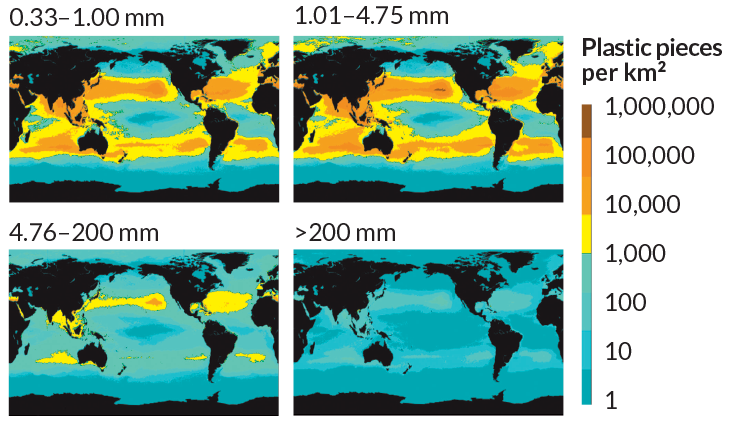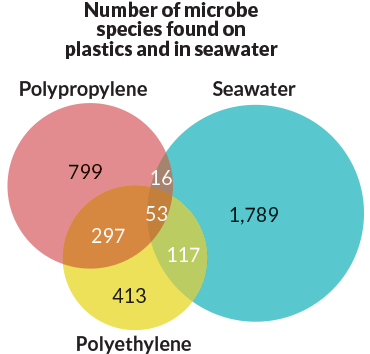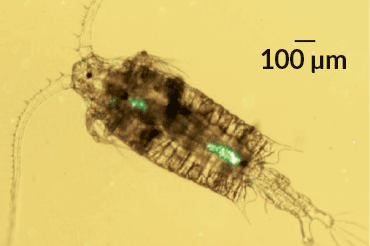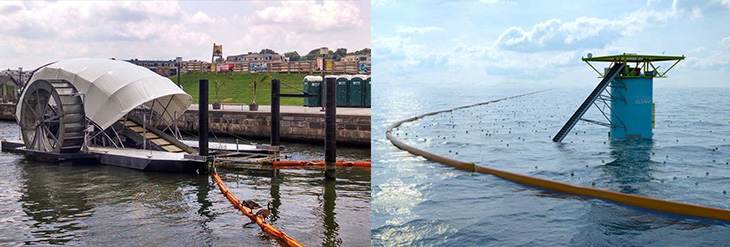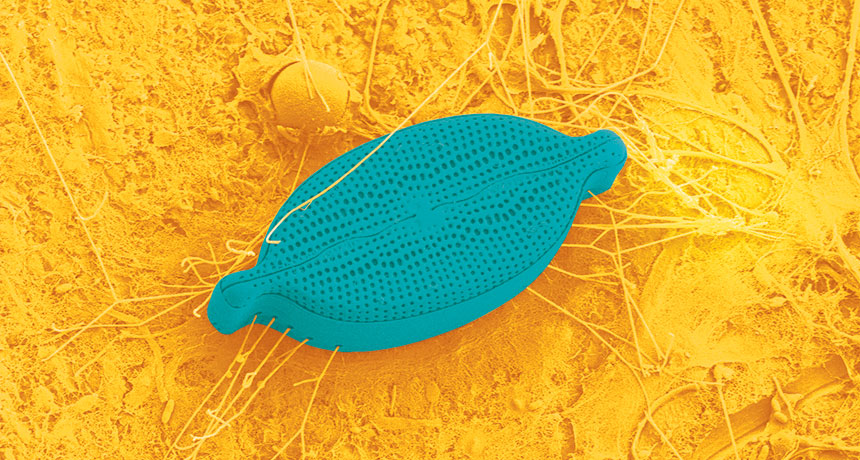
HITCHHIKER A microscopic diatom latches onto a tiny plastic piece from the Sargasso Sea (colors added).
E.R. Zettler/Sea Education Assoc., False color by E. Otwell
Oceanfront property doesn’t come cheap. Except, perhaps, for some seafaring microbes.
Steady streams of tiny plastic pieces making their way into the ocean give microbial squatters a place to take up residence. Each plastic home comes equipped with a solid surface to live on in an otherwise watery world. These floating synthetic dwellings and their microbial inhabitants have a name: the plastisphere.
Microbes of the plastisphere live in waters from Australia to Europe. They differ by location, are as varied as the plastic they live on and can be a tasty food option for other creatures. What impact — good or bad — the microbe-covered plastic has on the oceans is still in question. Early hints suggest that there may be climate effects and unexpected movement of harmful microbes or other creatures to new destinations. Each study sparks new ideas and new theories.
“This is an opportunity to learn about the ocean from a big experiment that has already been put in place by humans,” says marine chemist Tracy Mincer of the Woods Hole Oceanographic Institution in Massachusetts.
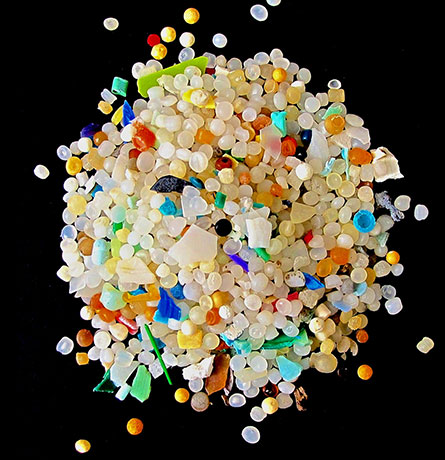
As the plastic multiplies
Plastic is everywhere. Finding it polluting the world’s oceans has been a worrisome reality for years. But a discovery more than four decades ago shocked a pair of Woods Hole researchers.
In 1972, scientists were trawling the surface of the Sargasso Sea in the North Atlantic Ocean to collect Sargassum, a brown algae seaweed. The researchers’ interest was diverted, however, by an unexpected catch: tiny plastic particles.
Repeated net tows caught more plastic. The researchers calculated an abundance of 3,500 small plastic pieces per square kilometer, and were left thinking about the future. “The increasing production of plastics … will probably lead to greater concentrations on the sea surface,” the researchers wrote in Science.
More recent estimates put the amount of plastic floating in the world’s oceans at more than 5.25 trillion pieces, weighing more than 268,000 metric tons (SN: 1/24/15, p. 4). That translates to as much as 100,000 pieces per square kilometer in some areas of the ocean.
In a few places, the concentration of plastic and other trash has earned a nickname or two. In the North Pacific Ocean, for example, the expanse between Japan and the U.S. western coast is variously known as the “great Pacific garbage patch” or the “Pacific trash vortex.”
These floating areas of debris aren’t visible to satellites, however. The ocean still looks blue because most of the junk is barely visible tiny bits of plastic.
These microplastics are no bigger than 5 millimeters across and come from many sources. Some are broken bits of larger plastic pieces. Others, such as synthetic fibers from clothing and plastic beads from toothpastes and face washes, escape cleaning filters at wastewater treatment plants and end up in the ocean.
Story continues after maps
“We treat millions of gallons of wastewater per day in the United States,” says Chelsea Rochman, a marine ecologist at the University of California, Davis. She describes the waste as “a concentrated stream” of debris going out into the ocean.
Diversity rules
During the 1972 expedition, the researchers found a handful of diatom species, single-celled algae, on the microplastics. It wasn’t until much later that scientists began to uncover the diversity of microbial life on this plastic flotsam.
In 2013, Mincer and colleagues found an ensemble of microbes thriving on microplastics collected from the North Atlantic Ocean. Some of the microbes made food from sunlight, some ate microbes and some lived on top of other microbes. The colonies grew on two abundant plastics — polypropylene and polyethylene — and were different from microbe populations in the surrounding seawater, the researchers reported in Environmental Science & Technology.
Polypropylene, which is often used in packaging, hosted 799 distinct microbe species that weren’t found on polyethylene or in the water. Likewise, 413 species were unique to polyethylene, the most common plastic produced worldwide. Seawater samples yielded 1,789 different microbes. Just 53 species populated both the water and the two types of plastic.
These numbers suggest that some microbes living on ocean plastic might not be found in the seawater otherwise. Or they may be present, but in amounts too low to detect. Another possibility is that the microbes hitchhiked on plastic from a different part of the ocean.
Beyond the Atlantic, microbes have been found populating plastics in Australian waters and the vast expanse of water between Hawaii and the continental United States. Coastal northern European countries have collected plastisphere microbes as well. Even the Great Lakes have microbes living on plastic, according to early work by Melissa Duhaime, a microbiologist at the University of Michigan in Ann Arbor.
In many cases, the microbe species differ depending on the water they occupy. There also seems to be a geographic footprint pointing to where the microbes originated, says Linda Amaral-Zettler, a marine microbial ecologist at the Marine Biological Laboratory in Woods Hole and a coauthor with Mincer on the 2013 paper.
Microbes on microplastics in the North Pacific differed from those in the North Atlantic, Amaral-Zettler, Mincer and colleagues reported in the December Frontiers in Ecology and the Environment. Along with geographic variation, the number of microbe species on the plastic pieces also correlated with latitude. Possibly tied to temperature, latitudes closer to the equator had more species than latitudes nearer the poles.
Microbe populations might also change with the seasons, says Caroline De Tender, a marine microbiologist at the Institute for Agricultural and Fisheries Research in Merelbeke, Belgium. “It’s something that we suspect is happening,” says De Tender, who got a sense of seasonal variety while analyzing plastic pieces from the North Sea near Belgium collected in March and August of 2014. Those results appeared last August in Environmental Science & Technology.
Other research supports the idea. Clear differences emerged among microbe communities when researchers left plastic water bottles exposed in the North Sea for six weeks at a time during winter, spring and summer in a study reported in 2014 in FEMS Microbiology Ecology. Knowing the geography and environmental factors could help researchers get a better handle on the amount of plastic going into the ocean and where it’s coming from.
The food chain
To understand the plastisphere, scientists must figure out why microbes congregate on plastic.
For one thing, a hard piece of plastic offers a solid surface to latch on to and grow on in the open ocean. Better still, the plastic acts like a meal plate, serving up an all-day buffet.
“A surface in the open ocean is a real advantage for these guys because it concentrates nutrients that they’re competing for,” Mincer says.
In the open ocean, the main ingredients of many ocean microbes’ diets, such as nitrogen and phosphorus, are often lacking. Like dust on a windowsill, nutrients suspended in seawater will collect on a hard surface. When a piece of floating plastic weighing about one gram is drenched in nutrients, it can grow a microbial community with more biomass than 1,000 liters of open seawater.
While plastic platters of nutrients keep microbes full, they also attract other critters that gobble the microbe-loaded plastic for dinner.
“They smell and taste like something that’s good to eat,” says Erik Zettler, a microbial ecologist at the Sea Education Association in Woods Hole, who has worked on projects with Amaral-Zettler (his spouse) and Mincer.
It seems that plastic has worked its way up the food chain. Observations of plastic in zooplankton, crabs (SN: 8/9/14, p. 9), fish, seabirds and turtles populate the scientific literature.
Rochman, of UC Davis, and colleagues looked for human-related debris such as plastic and textile fibers in fish being sold in Indonesian markets and from fish and oysters for sale in the United States. Out of 76 fish from Indonesia, 21 had plastic in their guts. In the United States, 15 of 64 fish and four of 12 oysters contained human-related debris, mostly fibers from textiles. At least six of the U.S.-sold fish carried plastics, the team reported in September in Scientific Reports.
Yet, Rochman says, there’s not enough research to say that people shouldn’t eat seafood, which is an important source of protein. “What we don’t want to do is turn people off to seafood,” she says. “I even eat oysters,” which can take in a lot of plastic.
Story continues after sidebar
Climate impact
When animals eat plastic, they don’t digest it, Rochman says. Any plastic that doesn’t get stuck in the digestive tracts of sea critters is let out in the water again. Some scientists think that pooped-out plastic could influence Earth’s carbon cycle by releasing climate-warming carbon dioxide back into the atmosphere.
The ocean acts as a big carbon dioxide sink. Normally, microscopic marine plants take up carbon dioxide from the atmosphere. When other organisms eat the plants, they digest what they can and excrete any leftovers as fecal matter that sinks to the ocean floor. That’s a good thing, Mincer says, “a geological burial of carbon.”
But plastic can destabilize fecal pellets, making them fall apart before they have a chance to sink to carbon-storage depths. When the plastic poop breaks up, it releases nutrients loaded with carbon and keeps carbon at shallow levels.
“What you get is a short-circuiting of [the carbon-storing] pump,” Mincer says. “You’re not getting effective sequestration and burial of that atmospheric carbon.”
Some pooped plastic could make it back to the plastisphere, where it has potential to crumble into even smaller bits. A single 200-millimeter plastic piece, for instance, could potentially split into more than 62,000 pieces. Waves and sunlight can speed the breakdown. Microbes might be helping as well.
At least a few microbes make pits and grooves on plastic, which might trigger breakage. In the Zettler report from 2013, a few microbes in the North Atlantic made pits in plastics that conformed to their rounded shapes. Similar microbes were found making marks in plastic off the coast of Australia. Whether it’s normal microbe wear and tear or a sign that the microbes are consuming the plastic is up for debate.
Even if they are munching on the plastic, microbes probably won’t rid the ocean of plastic anytime soon. “Most of what we’re finding is not on a timescale that is relevant to human existence,” says Duhaime, the Great Lakes microbiologist.
The long life of ocean plastic doesn’t just give microbes stable space and ready food. It also has the potential to move organisms outside of their native range, like an unanchored houseboat, ready to spread potentially harmful microbes.
“Ships only go port to port,” says David Barnes, a marine ecologist at the British Antarctic Survey. “Plastic goes everywhere.”
Ocean currents transport plastic, and anything on it, great distances; computer models show some plastics traveling more than 1,000 kilometers in less than 60 days. Barnes has studied washed-up plastic on islands around the world, and he found one piece that had been afloat for at least a year.
Ocean plastic may have helped spread a coral pathogen that causes skeletal eroding band disease from the South Pacific and Indian oceans to Hawaii and even the Caribbean, researchers reported in 2014 in Marine Biology. And that’s not the first time a potentially harmful organism has been found on plastic.
Vibrio — a fast-growing group of microbes, some of which can cause disease in fish and humans — has been found living on plastics in a couple of studies. Nearly a quarter of the microbe community from one piece of plastic from the Zettler 2013 study was made of vibrio. Usually, vibrio doesn’t make up much more than 1 percent of any microbe community.
Duhaime wonders whether some kind of microbe superbug could populate ocean plastics. In an extreme and entirely hypothetical scenario, such a microbe could embark on a trans-oceanic, transcontinental journey by traveling via ocean currents to different countries.
The plastisphere, created by human trash fouling the oceans, seems to offer a wealth of opportunity for microbes — a chance to eat well and, possibly, see the world. Scientists are just starting to uncover the complexities of this new ecosystem. With all the variables that can shape microbe communities on ocean plastics, says Amaral-Zettler, it’s hard to say what to expect.
This article appears in the February 20, 2016, issue with the headline, “Floating Fortress of Microbes: Microscopic creatures take advantage of plastic debris in the oceans.”
